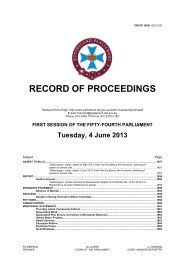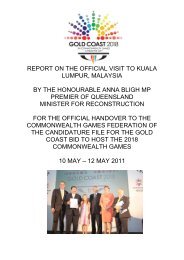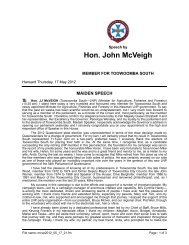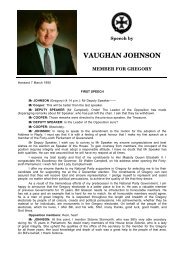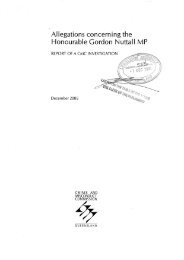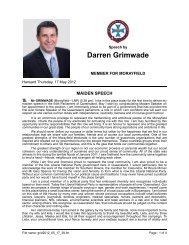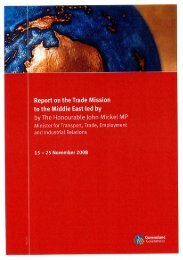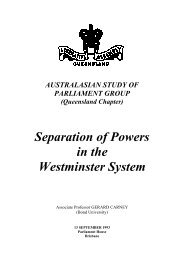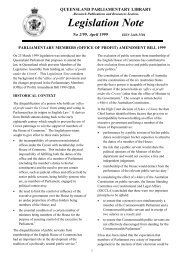weekly hansard - Queensland Parliament - Queensland Government
weekly hansard - Queensland Parliament - Queensland Government
weekly hansard - Queensland Parliament - Queensland Government
You also want an ePaper? Increase the reach of your titles
YUMPU automatically turns print PDFs into web optimized ePapers that Google loves.
23 Aug 2005 Plumbing and Drainage and Other Legislation Amendment Bill 2623<br />
a program of demand management options that will allow the most cost-effective delivery of water<br />
services to Cairns city, to develop a framework and a model for least-cost planning and demand/supply<br />
side options and to provide recommendations that will integrate planning to allow cost-effective decision<br />
making, which of course is in the best interests of not just the environment but also the ratepayers, who<br />
are going to be the ones who will fund any initiatives that come from this study.<br />
I would like, then, to turn to the conclusions and recommendations of this report. I said that it was<br />
long-awaited. One of the reasons it took such time to come to fruition was that negotiations had to be<br />
undertaken between the state government and the Cairns City Council. I must say that these at times<br />
were torturous. I am pleased to say that we have come to a resolution in terms of the way forward. I<br />
would like to commend Minister Desley Boyle for her involvement in achieving that outcome. It is vitally<br />
important that there is agreement between the state government and the city council as to how we<br />
proceed in this regard. I would like to make particular reference to the conclusions and<br />
recommendations from the study.<br />
Sitting suspended from 6.30 pm to 7.30 pm.<br />
Dr LESLEY CLARK: Before I describe the conclusions and recommendations of the least-cost<br />
planning study, however, I must explain that demand analysis has been made very difficult by the poor<br />
quality water consumption data supplied to the consultants by Cairns Water. The study revealed that<br />
Cairns Water does not actually know exactly where all of its water is going. The water consumption<br />
records show that the total consumption at times exceeded production—a miracle not even the best<br />
local government could achieve—and then there is a lack of any sort of regular seasonal pattern in the<br />
records of each sector. The consultants put the missing water that could not be accounted for at 20 per<br />
cent. It was an estimate, but it was the best they could do. But of that 20 per cent, they also estimated<br />
that half of that amount was due to system losses—that is, leakages. Based on the amount of water that<br />
is consumed every year in the Cairns city area, that means that approximately 2.5 billion litres of water<br />
is likely to be leaking out of the system every year. No wonder Cairns residents who are on permanent<br />
water restrictions are angry at that situation and it clearly points, as the consultants did, to a need to<br />
address that situation as a matter of urgency and develop better data records.<br />
Turning to the conclusions and recommendations—I want to read this into the Hansard record<br />
because it is so important—the conclusion states—<br />
Based on the assessment of least cost options for the Cairns Water supply it is concluded that:<br />
1. Analysis of the demand trends over the past five years indicates that the per capita demand reduced by 10% following the<br />
introduction of a two part tariff, but has rebounded by approximately half this amount over the past two years (after climate<br />
correction of demand).<br />
2. Per capita demand over the past three years averages 510 L/day including non-revenue water. This equates to an<br />
average of 26,000 ML/a of total demand.<br />
3. It is estimated that the total population served ... will grow to 252,000 to the year 2044. Bulk water supply of approximately<br />
48,000 ML/a will be required to cater for this population at current levels of consumption.<br />
4. Demand analysis was hampered by lack of quality customer database data. Resulted in difficulty in estimating the level of<br />
NRW—<br />
that is, non-revenue water—<br />
and the level of seasonal use in each consumer category.<br />
5. Constant per capita baseline has been assumed, but this should need to be monitored carefully in the coming years to<br />
ensure that any increase is identified and the appropriate adjustments made to the demand and supply programs.<br />
6. A range of demand management scenarios, consisting of groups of initiatives was assessed using an economic model to<br />
determine cost effectiveness. It was found that a program consisting of the following elements would best meet the<br />
objectives of the program:<br />
• Community education<br />
• Fixture efficiency code for new development<br />
• Showerhead retrofit program<br />
• Non-residential water audits<br />
• Non-residential external audit program<br />
• Mandatory fixture labelling<br />
• Minimum performance standards for water using fixtures and appliances<br />
• Establishment of Pressure Management Areas and District Metering Areas<br />
7. The Least Cost Plan for Cairns Water was found to be a combination of:<br />
• The development of the Mulgrave Aquifer as the next source of supply<br />
• Demand Management Program as outlined in Section 7.4.3.<br />
8. Cairns Water should also consider different options with respect to customer billing which would include inclining block<br />
tariffs and more frequent billing, with both access and usage charges on the one bill. The use of a ‘free’ allowance should<br />
be reconsidered in the context of a price signal to the customers.<br />
9. It is estimated that the implementation of the demand management program ... would cost approximately $3m over the<br />
next five years, at which stage the effectiveness should be fully reviewed. This approach will save approximately 7% over<br />
the baseline forecast, which will rise to 12% when taking account of recently implemented national water efficiency<br />
standards.



